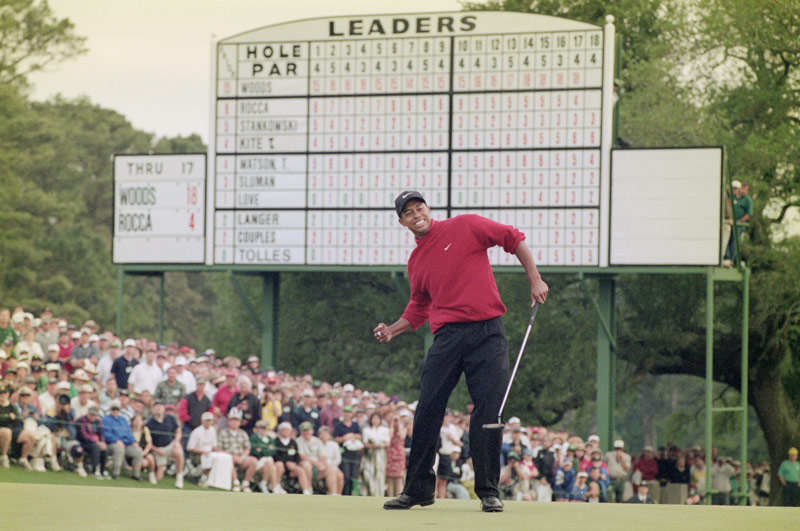
Tiger Woods wins the 1997 Masters, becoming the first Black golfer and youngest player to take the title, which he secured by the largest margin of victory in tournament history. Photo by Stephen Munday/Allsport/Getty Images
April 13, 1997.
It ranks as one of the most important dates, if not the most important, in golf. Its significance has certainly resonated in the career of broadcaster Jim Nantz. Not one to be unprepared, Nantz started cramming for April 13 on the night of April 12.
It was the eve of the final round of the 61st Masters. Sure, 18 holes remained. Yet it already looked like a done deal at Augusta National. By that Saturday night, 21-year-old Tiger Woods had a stranglehold on the lead, and it seemed certain 1996 champion Nick Faldo would soon be helping Woods into the champion’s green jacket.
Woods had built a hefty nine-stroke lead through 54 holes. Anybody who wanted to catch him had some serious work to do. Nantz labored over his role in what had all the makings of a where-were-you-when-it-happened occasion. The time seemed appropriate to deliver a litany of superlatives on what had been a jaw-dropping effort to that point by Woods. Nantz took all options into consideration.
“It’s such an important moment in the history of the game that I knew on Saturday night that a little narrative over the last putt, whatever it is, must be really good, because it’s going to be played back 10, 20, 50, 200 years from now. That clip is still going to be out there. It’s going to live forever,” Nantz says.
“The night before, I sat down and thought about all the voices of my youth, those who inspired me, most of whom were still alive, such as Pat Summerall and Jim McKay and Chris Schenkel and Jack Whitaker and Dick Enberg. I knew they would be watching the next day, and I certainly felt like they would want to see how I was going to handle that moment. It was just so big, and I felt pressure to really nail it, to be able to say something succinctly that sums up the very gravity of the moment.”
Relive Tiger Woods’ historic final shot — and Nantz’s famous call — at the 1997 Masters:
Such moments are incredibly rare. Fifty years before, in 1947, baseball legend Jackie Robinson busted the color barrier. In 1974, Hank Aaron belted his 715th career home run to surpass Babe Ruth on the all-time list. Six years later, the U.S. Olympic hockey team produced the “Miracle on Ice” by upsetting the USSR. Woods, meanwhile, was on the verge of becoming both the youngest player to win the Masters as well as the first Black golfer to win the title. His emergence was already being hailed as a defining moment that would draw in new golfers of all ages and ethnic backgrounds.
No wonder Nantz brainstormed. Pondered. Wondered. Grinded. He was determined to put this mammoth moment into a perspective that would resonate. Overloading an estimated record-setting 44 million viewers with information was not the way to achieve it, he decided. Ultimately, he settled on saying just a few words and letting the images do the rest.
Finally, the time came that late Sunday afternoon. Woods was comfortably in the driver’s seat. He stood over a nearly 4-foot par putt to complete his dominant performance. Woods sank it with ease. As the crowd that ringed the 18th green roared and Woods, wearing his staple Sunday red, unleashed a fist pump to top off his 12-stroke triumph, Nantz delivered what he had conceptualized — eight unscripted words for that final, historic sequence:
“There it is, a win for the ages!”
And there it is — the cap to a landmark event in golf. Nantz will forever be a part of it, and he is satisfied with his place in history.
“When I thought about it, I felt emotional knowing the gravity of the moment that would unfold on that fateful Sunday,” Nantz says. “I think we all realized it was going to be one of the biggest moments we were ever going to be asked to document, and I wanted to get it right. And it just felt like the right thing to say. And I felt very good about it.”
Editor’s note: Read much more from GCM’s conversation with Nantz about his career, his respect for golf course superintendents, his role in the Alzheimer’s fight and more in Jim Nantz: Calling the shots.
Howard Richman is GCM’s associate editor.